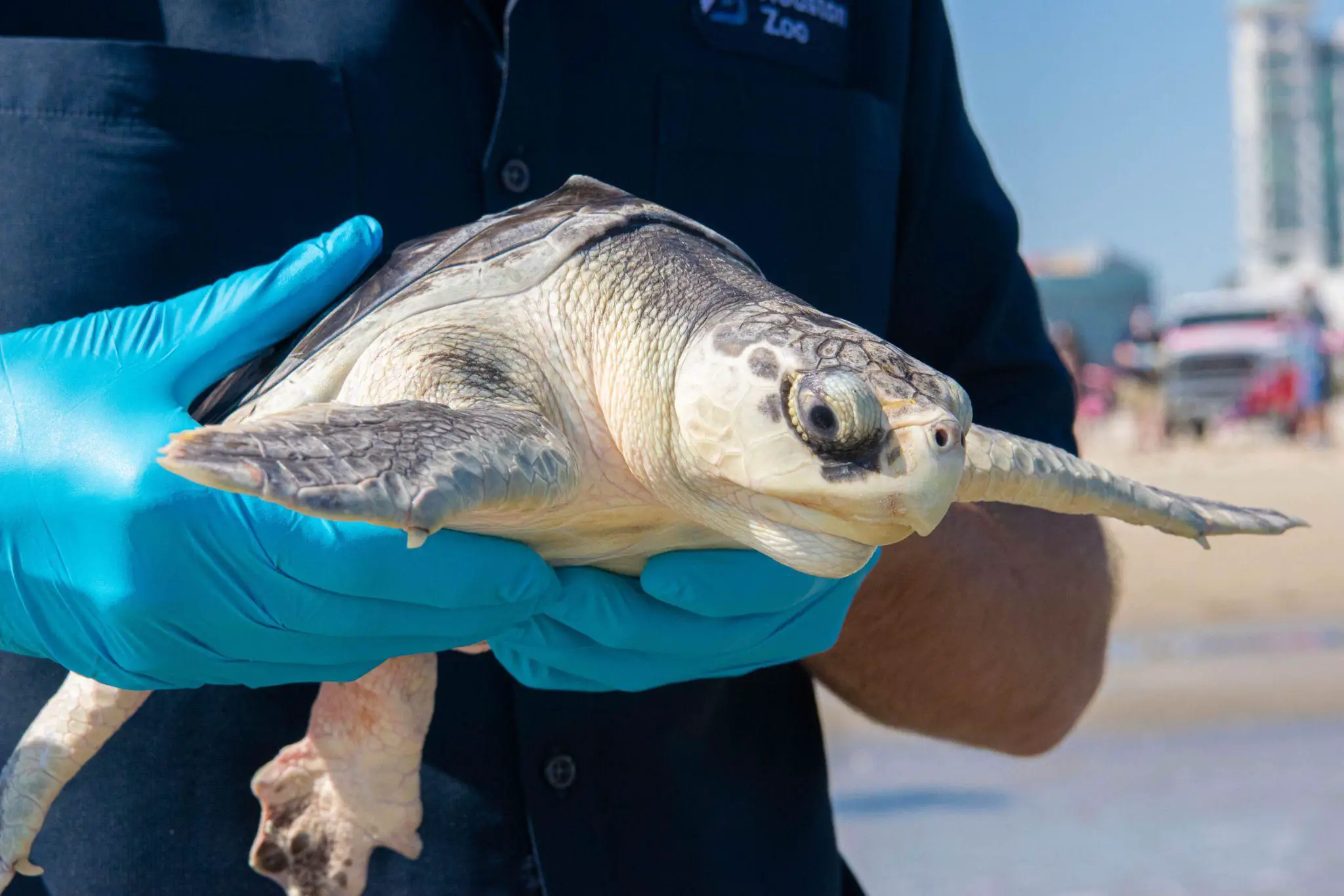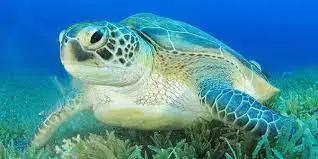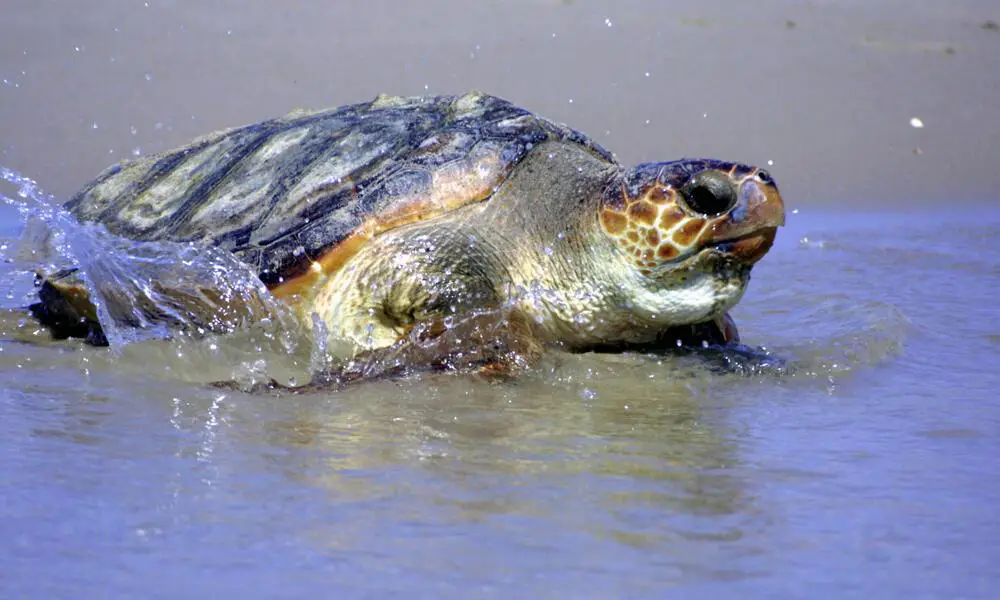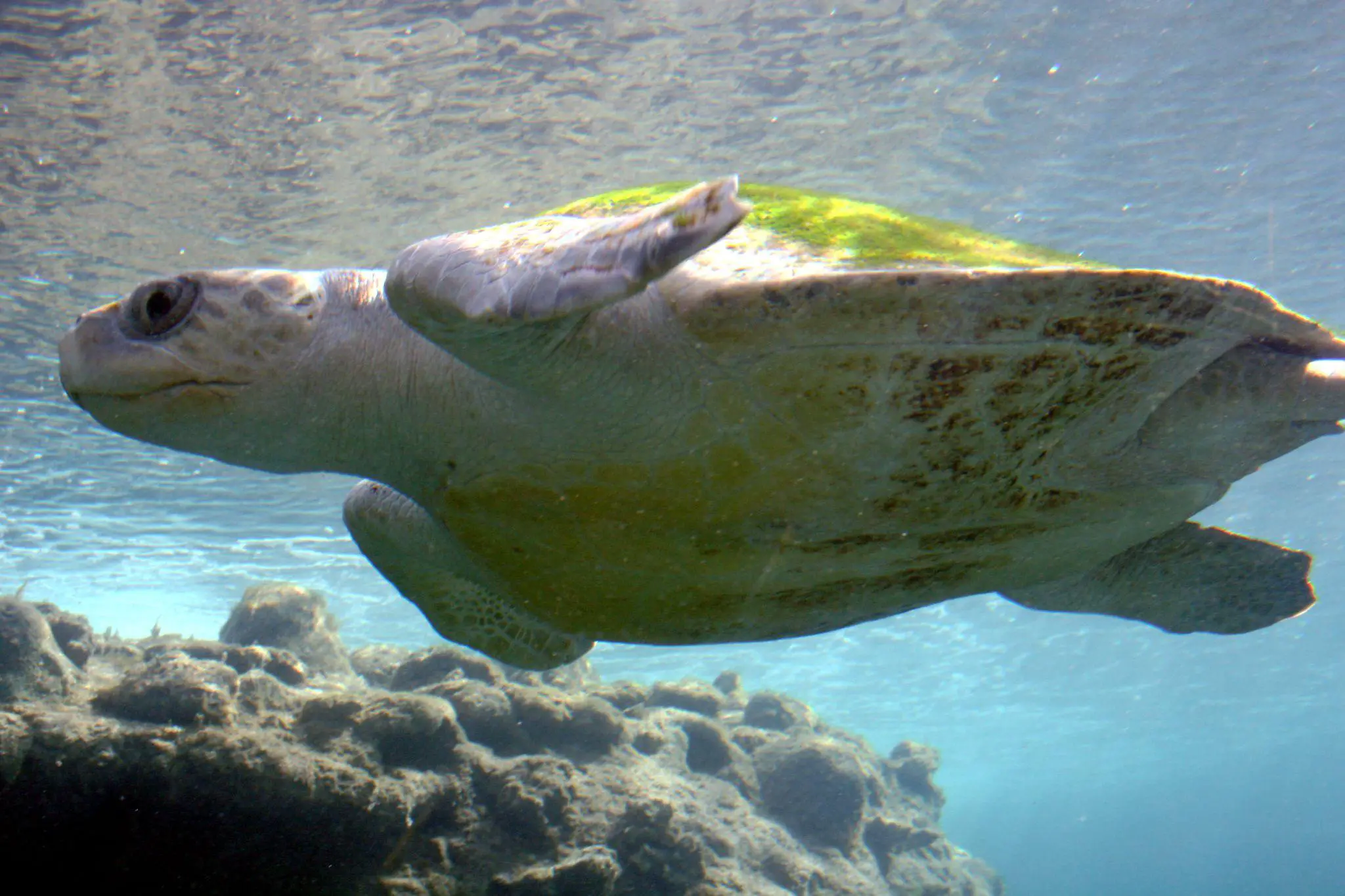The rarest sea turtles in the world
There are quite a few species of sea turtles left in the world due to the harmful effect of man on the sea. The rarest sea turtles in the world are the kemp’s ridley, green sea turtles, loggerhead sea turtle, and the olive ridley sea turtle.
First hand, we will talk about kemp’s ridley sea turtle the rarest sea turtle in the world, the rest of the species that we will talk about are endangered and at a high risk of extinction.
Kemp’s ridley sea turtle

Image credits S28164.pcdn.co
Despite the fact that it is uncertain where this species of turtle originated, it is known as the “Kemp’s ridley”. This is due to the fact that Harvard biologist Samuel Garman received the first specimen from Key West resident Richard Moore Kemp (1825–1908). L. kempii was once referred to as the bastard turtle before the word (used to refer to both species in the genus) became well-known.
The Kemp’s ridley is also referred to as a “heartbreak turtle” in at least one source. According to The Great Ridley Rescue author Pamela Philips, fisherman who saw the turtles’ deaths after they had been “converted turtles” are the ones who first coined the phrase “converted turtle” (on their backs). According to the fisherman, the turtles “died of a broken heart.”
Physical description
The Beaks, front limbs that mimic flippers, and dorsoventrally flattened bodies are characteristics of sea turtles.
The Kemp’s ridley sea turtle is the smallest species of sea turtle, maturing at 58-70 cm (23-28 in) in length and 36-45 kg in weight (79–99 lb).The adult carapace of a Kemp’s ridley turtle can reach a length of 75 cm (30 in) and weigh up to 50 kg (110 lb).
The head of the Kemp’s ridley turtle is triangular and features hooked beaks. On both sides, hatchlings are darkly pigmented. Adults often have a top that is grayish-green and a gorgeous, golden bottom. The length and width of the top shell (carapace) are typically equal. Unlike the back flippers, which may have one or two claws, each front flipper has just one.
Behavior and diet
All sea turtles, including Kemp’s ridleys, are aquatic reptiles and must surface to breathe. Adult sea turtles come ashore to lay their eggs in the sand. These amazing navigators frequently make their way back to the coast from where they first surfaced many years ago.
One of the two species of sea turtles, the Kemp’s ridley, builds “arribada” nests in which several females gather offshore before concurrently migrating to the beach to lay their eggs.
Large-scale nesting may be a response to environmental factors that influence nesting or a defense tactic against a predator. Since many turtles come ashore at once and many nests subsequently hatch at once, a high number of hatchlings entering the water at once may serve to overwhelm predators and ensure that more hatchlings make it to the sea to reduce predation. Another type of marine turtle that constructs its nests in close proximity to one another is the olive ridley sea turtle. These are the only sea turtles that consistently lay their eggs during the day.
Fish, shrimp, snails, clams, jellyfish, sea stars, and crabs make up the majority of their diet. People (hunting, boat propellers, nets, and waste) are the main predators of Kemp’s ridley sea turtles; shorebirds, sharks, and other marine animals then naturally prey on these humans.
Population status
The Endangered Species Act states that the Kemp’s ridley marine turtle faces extinction. Before the middle of the 20th century, there were several Kemp’s ridley turtles in the Gulf of Mexico. Tens of thousands of Kemp’s ridley birds may be seen nesting in Rancho Nuevo, Mexico, in a 1947 home footage.
This nesting population saw a sharp decline from the late 1940s to the middle of the 1980s. In 1985, there were just 702 nests, a record low, and less than 250 nesting females.As a consequence of diligent conservation efforts, the Kemp’s ridley began to gradually recover in the 1990s. Up until 2009, nests grew annually by around 15%.
The number of nests has fluctuated since 2010, when this swift and unexpected surge abruptly came to an end. The unexpected change in Kemp’s ridley nesting emphasizes how crucial continued protection, monitoring, and conservation efforts are.
95% of all Kemp’s ridley nesting takes place on the beaches of the western Gulf of Mexico and Tamaulipas, Mexico, throughout the entire world.
In Tamaulipas, Rancho Nuevo, Tepehuajes, and Barra del Tordo are the three primary nesting beaches. The nesting rates are substantially lower in Texas and Veracruz, Mexico. Occasionally, nesting activity has been seen in Georgia, Florida, North Carolina, South Carolina, and Alabama.
The Kemp’s Ridley marine turtle, which was included in the Endangered Species Act’s list of vulnerable and endangered species in the US in 1970, is the most endangered species of marine turtle. The only important breeding area for the Kemp’s Ridley is a little stretch of sand at Rancho Nuevo, Mexico.
In arribadas, which are organized mass nestings, they reproduce. This word signifies “arrival” in Spanish. Typically, the arribada occurs from April until June.
Green sea turtles

Image credits Nwf.org
The enormous Pacific green turtle, also known as the black turtle, green turtle, and Chelonia mydas, is a member of the Cheloniidae family. There is just one species in the genus Chelonia. In the tropical and subtropical seas of the Atlantic, Pacific, and Indian oceans, there are two separate populations. The common name alludes to the often green fat under the carapace rather than the olive-to-black color of the shell. mostly inhabit protected shorelines, islands, and coastal regions along the coast, particularly in areas with seagrass beds. They are very infrequently observed in the open ocean.
Physical description
The simplest method to identify a green sea turtle is by its top shell. The majority of the animal’s body is encased in its shell, with the exception of its head and flippers. The shell of a green sea turtle is not always green, despite its name. The continuous, heart-shaped shell comes in a variety of colors, including brown, olive, gray, and even black. The green sea turtle has a brown and yellow pattern on its head, and its underbelly is white with a golden hue.
Due to their paddle-like flippers, green sea turtles can move fast and easily through the water. These large, hefty creatures can grow to be three to four feet long and 350 pounds in weight (136 to 159 kilograms).
Behavior and Diet
Throughout its existence, it undergoes several alterations. When they grow to a length of 8 to 10 inches, worms, young crustaceans, aquatic insects, grasses, and algae should all be eaten. The green turtle, which mostly eats sea grass and algae, is the only marine turtle that entirely switches to herbivory as an adult after reaching 8 to 10 inches in length. Because of their very sharp teeth, their jaws are capable of tearing apart vegetation.
Population status
mostly inhabit protected shorelines, islands, and coastal regions along the coast, particularly in areas with seagrass beds.
They are very infrequently observed in the open ocean.Estimates indicate that since 1950, the population of green sea turtles has dropped by 90%, making them an endangered species. A few of the problems that put many animals at danger of dying are fibropapilloma, climate change, and habitat loss.
Hatchlings that live close to sea turtle nesting areas are at risk from light pollution because it may cause them to become disoriented and turn away from the water and toward the light. The overfishing of green sea turtles and their prey, particularly for sea turtle soup, is another issue.The number of green sea turtles is periodically counted by the National Marine Fisheries Service of the National Oceanic and Atmospheric Administration.
Regulations at the federal, state, and international levels protect green sea turtles. Restoration efforts are already underway in locations like the Guld of mexico.
Many Florida coastal municipalities have implemented illumination limitations to improve hatchling survival rates.
Bycatch, or the unintentional capture of green sea turtles by commercial and recreational fishers, has declined as a result of modifications to fishing practices, equipment (such as the addition of TEDs, or turtle exclusion devices), and the prohibition on fishing in particular areas during nesting and hatching seasons. Sea turtles travel great distances between their nesting beaches and feeding grounds, thus continual international cooperation is essential for the recovery and stability of nesting populations, according to the U.S. Fish & Wildlife Service.
Loggerhead sea turtle

Image credits Files.worldwildlife.org The Caretta caretta, a species of loggerhead sea turtle, is widespread around the world. It is a member of the Cheloniidae family of marine reptiles. The typical loggerhead’s carapace measures about 90 cm (35 in) in length when completely grown. The largest species of loggerhead sea turtles can weigh more than 450 kilograms, despite the fact that the average adult weighs just about 135 kilograms (298 pounds) (1,000 lb). Although the flesh can be any hue between yellow and brown, the shell often has a reddish brown tint. The turtle doesn’t exhibit any telltale signs of sex behavior until it is an adult. Mature males have shorter plastrons and thicker tails than adult females (bottom shells).
Physical description
Large heads and strong jaws are features of loggerhead turtles. The bottom shell (plastron), which normally has a light yellowish hue, is joined to the top shell (carapace), which is typically somewhat heart-shaped and reddish-brown in adults and subadults. The bottom and sides of the neck and flippers are often medium to pale yellow, while the top and sides are typically dull brown to reddish brown. Sea turtles are unable to retract their heads or flippers into their shells like freshwater turtles and tortoises can. Hatchlings often have a dark brown tint, along with a bottom shell that is yellowish to tan in color and white to white-gray borders on their flippers.
Behavior and diet
Because they are aquatic reptiles, loggerhead sea turtles must surface in order to breathe. Adult sea turtles land on the shore to lay their eggs in the sand.
These incredible navigators frequently halt at the same beach from which they first arrived years ago.
Before becoming adults, loggerhead turtles go through a number of developmental stages. A juvenile or hatchling spends the first seven to fifteen years of its life in the open ocean. Then they relocate to nearby coastal locations to continue growing and grazing for a short while longer.
From their feeding areas, adult loggerhead turtles migrate tens of thousands of kilometers to their breeding beaches.
Studies show that loggerhead turtles use satellite navigation to cross the Pacific. From their nesting sites in Japan and Australia, hatchlings fly nearly 8,000 miles across the Pacific Ocean to dine on the beaches of Baja California, Mexico, Peru, and Chile.
They may spend up to 20 years maturing before returning to the Western Pacific Ocean beaches where they were hatched to mate, lay their eggs, and spend the rest of their life.
Carnivores that hardly ever consume plant materials are loggerhead turtles. While in the open ocean, they consume a range of floating things. Unfortunately, their environment is regularly polluted by waste left by humans and other animals.
Small pieces of plastic are frequently mistaken for food by turtles, who then eat them. Adults and juveniles in coastal waters mostly eat bottom-dwelling crustaceans like horseshoe crabs, different mollusks, and other crabs. Their powerful jaws are designed to rip apart their prey.
Population status
The main danger to sea turtles is accidental entanglement in fishing gear, which can cause drowning or injuries that can be fatal or severely disable them (for example, swallowing hooks). Bycatch is the term for an unintentional capture.
Marine turtle bycatch is a serious problem. Bycatch in fishing gear, specifically in trawls, longlines, gillnets, hook-and-line, but also in pound nets, pot/traps, and dredge fisheries, is the primary ongoing danger to loggerhead turtle populations around the world.
The meat and eggs of turtles, notably loggerhead turtles, have been taken for human consumption in a number of nations.
In the vast majority of the nations where they are found, loggerhead turtles are officially protected, but in other areas, the killing of loggerhead turtles and the collecting of their eggs still pose a threat.
Loggerhead turtle breeding beaches are being destroyed by coastal development and the rising sea levels brought on by climate change.
The complete disappearance of dry sand that is appropriate for effective hatching might be caused by shoreline hardening or armoring (such as seawalls). Artificial lighting can dissuade nesting females from coming ashore to lay their eggs and can cause hatchlings to get lost in the water after leaving their nests on nesting beaches and in the vicinity of them.
All sea turtles are under risk as a result of the growing contamination of the marine ecosystems offshore and close to shore. Floating tar or oil, plastic bags, fishing line, and other human-discarded objects that they can mistake for food can all be fatal to loggerhead turtles.
All sea turtle species would probably notice alterations in beach form, higher sand temperatures that can harm eggs, or a change in the ratio of male to female hatchlings generated as a result of a warmer climate.
Due to coastal erosion brought on by storms and rising sea levels, nests may be swamped or pushed away.
Temperature variations in the maritime environment would undoubtedly alter the quantity and distribution of food supplies, which would alter the loggerhead turtles’ migratory and foraging ranges as well as their breeding season.
Nine distinct population segments (DPS) of loggerhead turtles are classified as vulnerable or endangered under the Endangered Species Act. Only two loggerhead nesting beaches—South Florida and Oman—have more than 10,000 females deposit eggs annually, according to the most current study. Oman has the second-largest loggerhead nesting population worldwide, per the most recent trend data.
Olive ridley sea turtle

Image credits Upload.wikimedia.org
The Cheloniidae family includes the species of turtle known as Lepidochelys olivacea, often known as the Pacific ridley sea turtle. The turtle is the second-smallest and most prevalent marine turtle in the world. L. olivacea may be found in the warm waters of the Atlantic, Pacific, and Indian oceans.
The related turtle also The Kemp’s ridley turtle is recognized for its impressive mass synchronized nestings, or arribadas, which occur when numerous females gather to lay eggs on the same beach.
Physical description
The head is really little. They have massive scutes and a ridgeless, bony carapace (scales). The smooth, often spherical carapace bears six or more discernible lateral scutes. Compared to the closely related Kemp’s Ridley sea turtle, its body is deeper. There are one or two visible claws on both the front and rear flippers. The front flippers may have an additional claw. Adults have a dark grey green tint, whereas children have a charcoal gray color. When they are damp, a hatchling’s sides have a greenish black hue.
Behavior and diet
Unfortunately, nothing is known about the behaviors of this turtle. To avoid the frigid seas, turtles have been spotted sunning together in the sun.
Algae, fish, lobster, crabs, tunicates, mollusks, shrimp, and other sea life are among the animals and plants that the omnivorous olive ridley eats. Olive ridleys can be seen hunting for invertebrates up to a depth of 500 feet (150 meters).
Population status
The federal government has listed some Olive Ridley populations as threatened or endangered, and the sea turtle is regarded as being extremely fragile on a worldwide basis. Marine pollution, unintentional capture (especially in shrimp trawl nets and nearshore gill nets), and taking marine species for its flesh and skin are all threats to marine life.
For olive ridleys, both national and international laws and agreements are relevant. Olive ridley populations are routinely observed by the U.S. Fish & Wildlife Service and NOAA’s National Marine Fisheries Service. Bycatch, or the accidental capture of olive ridley sea turtles by commercial and recreational fishers, has decreased. When eggs are laid and hatch, specific regions are off-limits to fishing, and fishing techniques and equipment are modified to achieve this (e.g., by utilizing TEDs, or turtle exclusion devices). For the long-term protection of the species, a number of Mexican nesting beaches have been transformed into reserves.
Conclusion
The ridley sea turtles are all at at a great rick of extinction the main causes of their extinction are them being hunted for their shell and some for their flesh. Another cause of the death of the sea turtles are them getting caught up in plastic waste either by chewing polythene bags of by straws gettingf stuck in their nose. Th IUCN is taking steps inorder to save these turtles especially the kemp’s ridley sea turtle.
The kemps ridley sea turtle is the rarest turtle of all and is at a high risk of extinction. FAQs
Which species of sea turtles are most at risk?
Kemp’s ridley turtles are not simply the world’s tiniest and rarest species of sea turtle; they also have a two-foot diameter and weigh between 70 and 100 pounds each.
What physical traits do sea turtles have?
Due to their non-retractable head and limbs, as well as their large, streamlined shell, sea turtles have a distinctive look. Sea turtles can’t retract their heads and limbs inside of their shells as other turtles can. Due to the swimming-specific flippers on their limbs, they are exposed when on land.
An olive ridley turtle is what sort of turtle?
an image of an olive-sided sea turtle
An olive ridley turtle’s upper shell has a heart-shaped carapace with 5 to 9 pairs of scutes and an olive/grayish green tint. Each of an olive ridley’s four flippers has one or two claws. The biggest olive ridleys, which come in a range of sizes and forms, are found in West Africa.
What adjectives would you use to characterize the sea turtles?
The large, streamlined shell of a sea turtle makes it easy to identify them. Sea turtles can be olive green, yellow, greenish-brown, reddish-brown, or even black depending on the species. Flippers and limbs have been modified for swimming. Both sexes of adult sea turtles are the same size.







